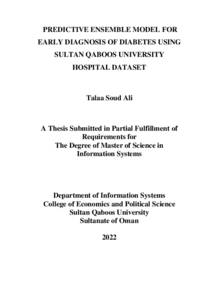وثيقة
Predictive ensemble model for early diagnosis of diabetes using Sultan Qaboos University Hospital Dataset.
عناوين أخرى
نموذج أساسي تنبؤي للتشخيص المبكر لمرض السكري باستخدام مجموعة بيانات مستشفى جامعة السلطان قابوس
الناشر
Sultan Qaboos University.
ميلادي
2022
اللغة
الأنجليزية
الموضوع
الملخص الإنجليزي
Diabetes Mellitus is a public health challenge with social and economic consequences
for nations irrespective of their economic stability. The Ministry of Health reports that
diabetes is on the rise for Omanis and has increased to the extent that it is the second ranked most prevalent disease among non-communicable diseases, a significant cause
of health loss condition in Oman. Despite this, diabetes is preventable by accepting a
healthier lifestyle. Thus, an appropriate tool for prognosis can assist the doctors in
detecting the disease early and recommending the necessary lifestyle changes to reduce
its progress. Information overloaded to the Clinic and health care centres for the patients
that require sophisticated analysis tools and techniques to extract valuable knowledge
and transform them into understandable patterns for decision-making. The latest data
mining techniques, including ensemble algorithms, can be applied to significantly
obtain the hidden patterns from the voluminous dataset to improve the diagnosis of
diabetes at the initial stage of pre-diabetes. This research aims to construct a predictive
ensemble model that can significantly classify and predict diabetes at the earliest stage
accurately using the dataset collected from the Sultan Qaboos University Hospital
database from Jan 2019 to October 2021. The ensemble model overcomes the variance
problem of individual algorithms by combining the prediction results from different
algorithms to create strong prediction results. The study applied five supervised
classification algorithms to build the Stacking and Voting ensemble models, including
Random Forest (RF), Decision Tree (J48), K-Nearest Neighbours (KNN), Support
Vector Machine (SVM), and Naïve Bayes (NB). These algorithms were evaluated using
different performance evaluation metrics, including recall, accuracy, AUC curve and
precision, and validated using the cross-validations process to overcome the bias of the
individual algorithms. The outperform algorithm is then used to demonstrate the
utilisation of the model and discover the hidden knowledge in the dataset. The study
outcomes confirm that accuracy achieved by the ensemble algorithms, including
stacking, and voting models, produce promising results compared to other techniques
for learning from complex datasets due to combining different prediction results from
the individual algorithms. Because the stacking algorithm combines the correct
prediction results from the individual classifiers, it provides the most accurate results
of 86.9% and an AUC curve of 86.9% in predicting diabetes. Therefore, it can be used
as an automatic prognostic tool to improve the diagnosis system in healthcare.
However, it can be optimised further to progress prediction accuracy by including the
significant risk factors in predicting diabetes. An improved diabetes diagnosis system
using machine learning methodologies results in the awareness and accelerating
decision-making that may help physicians and doctors understand the disease better and
enhance proper treatment. Consequently, it reduces hospitalisations, improves clinical
outcomes, and minimises health expenditure for government and individuals.
المجموعة
URL المصدر
الملخص العربي
داء السكري هو أحد تحديات الصحة العامة وله آثار اجتماعية ومالية على الدول بغض النظر عن وضعها الاقتصادي. وبحسب وزارة الصحة ، فقد ارتفع معدل انتشار مرض السكري بين العمانيين إلى درجة أنه يحتل المرتبة الثانية بين الامراض غير المعدية ، وهو سبب مهم لفقدان الصحة في عمان. على الرغم من ذلك ، يمكن الوقاية من مرض السكري إلى حد كبير من خلال اتباع أسلوب حياة أكثر صحة. وبالتالي ، يمكن ألداة التشخيص المناسبة أن تساعد الاطباء في اكتشاف المرض مبكًرا والتوصية بالتغييرات الضرورية في نمط الحياة لتقليل تقدمه. المعلومات المثقلة بالعيادة ومراكز الر عاية الصحية للمرضى والتي تتطلب أدوات وتقنيات تحليل متطورة الستخراج المعرفة القيمة وتحويلها إلى أنماط مفهومة التخاذ القرار.يمكن تطبيق أحدث تقنيات استخراج البيانات ، بما في ذلك خوارزميات المجموعات ، للحصول بشكل كبير على الانماط المخفية من مجموعة البيانات الضخمة لتحسين تشخيص مرض السكري في المرحلة الاولى من مرحلة ما قبل السكري. يهدف هذا البحث إلى بناء نموذج تجميع تنبؤي يمكنه تصنيف مرض السكري والتنبؤ به بشكل كبير في المرحلة الاولى بدقة باستخدام مجموعة البيانات التي تم جمعها من قاعدة بيانات مستشفى جامعة السلطان قابوس في الفترة من يناير 2019 إلى أكتوبر .2021 يتغلب نموذج المجموعة على مشكلة التباين في الخوارزميات الفردية من خلال الجمع بين نتائج التنبؤ من خوارزميات مختلفة لخلق نتائج تنبؤ قوية. طبقت الدراسة خمس خوارزميات تصنيف خاضعة لإلشراف لبناء نماذج وآلة (KNN (Neighbours Nearest-K) 48J (مجموعات التكديس والتصويت ، بما في ذلك شجرة القرار تم تقييم هذه الخوارزميات .(NB (Bayes Naïve و (RF (والغابة العشوائية (SVM (المتجهات الداعمة والتحقق من صحتها باستخدام AUC باستخدام مقاييس مختلفة لتقييم الاداء مثل الدقة والدقة والاسترجاع ومنحنى عملية التحقق من الصحة للتغلب على تحيز الخوارزميات الفردية. ثم يتم استخدام خوارزمية الاداء المتفوق لتوضيح استخدام النموذج واكتشاف المعرفة المخفية في مجموعة البيانات.تؤكد نتائج الدراسة أن الدقة التي حققتها خوارزميات المجموعة ، بما في ذلك نماذج التكديس والتصويت ، تنتج نتائج واعدة مقارنة بالتقنيات الاخرى للتعلم من مجموعات البيانات المعقدة بسبب الجمع بين نتائج التنبؤ المختلفة من الخوارزميات الفردية. نظ ًرا ألن خوارزمية التكديس تجمع بين نتائج التنبؤ الصحيحة من المصنفات الفردية ، فإنها توفر أكثر النتائج دقة بنسبة ٪86.9 ومنحنى الجامعة الامريكية بالقاهرة بنسبة ٪86.9 في التنبؤ بمرض السكري. لذلك ، يمكن استخدامه كأداة تشخيصية تلقائية لتحسين نظام التشخيص في الرعاية الصحية. ومع ذلك ، يمكن تحسينه بشكل أكبر لإحراز تقدم في دقة التنبؤ من خلال تضمين عوامل الخطر المهمة في التنبؤ بمرض السكري. يؤدي تحسين نظام تشخيص مرض السكري باستخدام منهجيات التعلم الالي إلى زيادة الوعي وتسريع عملية اتخاذ القرار التي قد تساعد الاطباء والاطباء على فهم المرض بشكل أفضل وتعزيز العالج المناسب. وبالتالي ، فإنه يقلل من دخول المستشفى ، ويحسن النتائج .السريرية ، ويقلل الانفاق الصحي للحكومة والافراد.
قالب العنصر
الرسائل والأطروحات الجامعية

